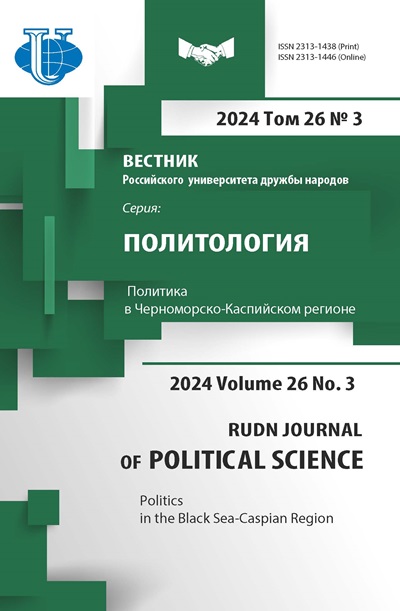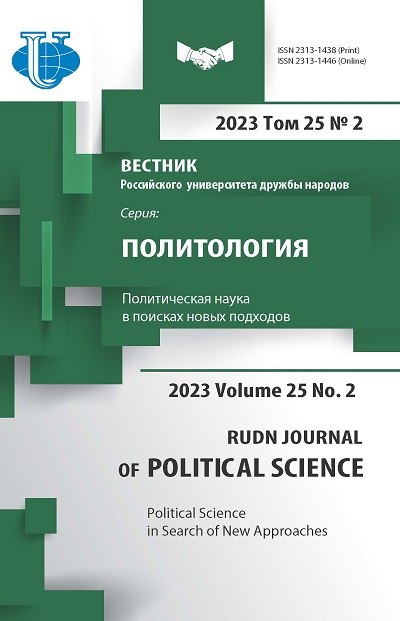Integration of Migrants Through the Lens of a Constructivist Approach to Ethnicity
- Authors: Varshaver E.A.1,2
-
Affiliations:
- The Russian Presidential Academy of National Economy and Public Administration
- Higher School of Economics
- Issue: Vol 25, No 2 (2023): Political Science in Search of New Approaches
- Pages: 377-396
- Section: POLITICAL PHENOMENA AND STRATEGIES
- URL: https://journals.rudn.ru/political-science/article/view/35157
- DOI: https://doi.org/10.22363/2313-1438-2023-25-2-377-396
- EDN: https://elibrary.ru/XICTAA
Cite item
Full Text
Abstract
The article rethinks the integration of migrants through the lens of constructivist studies of ethnicity. It is done on the basis of the theoretical language developed by the author, which builds upon other constructivist languages. It is pointed out that ethnicity is the organization of differences around categories, membership in which is predominantly inherited. Categories, according to language, are organized in the form of categorizations, classifications, and taxonomies; categories are associated with attributes, which include stereotypes, indicators, norms, characteristics of relationships with other categories, as well as discourses. Together, categories and attributes form the construction of ethnicity, which is a typical object of analysis and description. Individuals constantly evaluate the surrounding phenomena in terms of conformity with the construction of ethnicity, which is why the construction of ethnicity changes. Integration is a change in the construction of ethnicity or re-categorization of individuals in the space of the dichotomy «migrant» - «local» without changing the construction of ethnicity. In the course of integration, «migrant» categories may be re-categorized as «local»; «local» categories may change the attributes associated with them to include attributes previously associated with «migrant» categories; categories and attributes may not change, while re-categorization occurs at the individual level. How exactly integration will take place depends on a variety of factors that characterize the construction of ethnicity and go beyond it. The construction of ethnicity in Russia is a vernacular taxonomy, which implies the existence of a general category (‘Rossijane’, ‘Russkie’), which includes other categories - defined as the «local» ones. Most of the «migrant» categories correspond to identical in name «local» categories. The integration of migrants in Russia thus takes the form of an individual transition from the category of «Tajik migrants» to «local Tajiks». The language created and studied for applicability to the integration of migrants is analyzed for pros and cons and directions for further work are identified.
About the authors
Evgeni A. Varshaver
The Russian Presidential Academy of National Economy and Public Administration; Higher School of Economics
Author for correspondence.
Email: varshavere@gmail.com
ORCID iD: 0000-0002-5901-8470
PhD in Sociology, Ssenior Researcher of the Centre of Regional and Urban Studies, RANEPA; Head of the Migration and Ethnicity Research Group, Associate Professor of the Sociology Department of the National Research University - Higher School of Economics
Moscow, Russian FederationReferences
- Alleyne, M.C. (2002). The Construction and Representation of Race and Ethnicity in the Caribbean and the World. Kingston: University of West Indies Press.
- Arutiunova, E.M. (2008). Perception of Migrants in Russia and Europe: Comparative Analysis. RUDN Journal of Sociology, (3), 66–73. (In Russian).
- Barth, F. (1969a). Pathan Identity and its Maintenance. In F. Barth (Ed.), Ethnic Groups and Boundaries: The Social Organization of Culture Difference ( pp. 117–134). Boston: Little, Brown, Series in Anthropology.
- Barth, F. (1994). Enduring and emerging issues in the analysis of ethnicity. In H. Vermeulen & C. Govers (Eds.), The Anthropology of Ethnicity: Beyond “Ethnic Groups and Boundaries”. (pp. 11–32). Amsterdam: Het Spinhuis.
- Barth, F. (Ed.) (1969b). Ethnic Groups and Boundaries: The Social Organization of Culture Difference. Boston: Little, Brown, Series in Anthropology.
- Benzecry, C.E. & Winchester, D. (2017). 2 Varieties of Microsociology. In C.E. Benzecry, M. Krause, I.A. Reed (Eds.), Social Theory Now (pp. 42–74). Chicago: University of Chicago Press, 2017. https://doi.org/10.7208/9780226475318-003
- Berg-Sørensen, A., Holtug, N. & Lippert-Rasmussen, K. (2010). Essentialism vs. constructivism: Introduction. Distinktion: Scandinavian Journal of Social Theory, 11(1), 39–45. https://doi.org/10.1080/1600910X.2010.9672754
- Brubaker, R. (2009). Ethnicity, race, and nationalism. Annual Review of Sociology, 35, 21–42.
- Chandra, K. & Wilkinson, S. (2008). Measuring the Effect of “Ethnicity”. Comparative Political Studies, 41(4/5), 515–563. https://doi.org/10.1177/0010414007313240
- Chandra, K. (2006). What is Ethnic Identity and Does it Matter? Annual Review of Political Science, 9(1), 397–424. https://doi.org/10.1146/annurev.polisci.9.062404.170715
- Chandra, K. (Ed.). (2012). Constructivist theories of Ethnic Politics. Oxford (NY): Oxford University Press.
- Cosmides, L., Tooby, J. & Kurzban, R. (2003). Perceptions of race. Trends in cognitive sciences, 7(4), 173–179. https://doi.org/10.1016/S1364-6613 (03)00057-3
- Esser H. (2001). Integration und Ethnische Schichtung. (Arbeitspapiere 40). Mannheim: Mannheimer Zentrum für Europäische Sozialforschung.
- Fearon, J.D. & Laitin, D.D. (2000). Ordinary language and external validity: Specifying concepts in the study of ethnicity. Presented in the discussion at the LiCEP meetings at the University of Pensylvania. Oct. 20–22, 2000. Philadelphia: University of Pensylvania.
- Fearon, J.D. (2003). Ethnic structure and cultural diversity by country. Journal of Economic Growth, 8(2), 195–222. https://doi.org/10.1023/A:1024419522867
- Gibson, W. & vom Lehn, D. (2018). Institutions, Interaction, and Social Theory. R. Stones (Ed.), London: Palgrave.
- Gil-White, F.J. (2001). Are ethnic groups biological “species” to the human brain? Essentialism in our cognition of some social categories. Current anthropology, 42(4), 515–553. https://doi.org/10.1086/321802
- Goetze, D.B. & James, P. (2004). Evolutionary psychology and the explanation of ethnic phenomena. Evolutionary Psychology, 2(1), 142–159. https://doi.org/10.1177/147470490400200120
- Gudkov, L. (2005). Displaced aggression: attitudes of Russians towards immigrants. Bulletin of Public Opinion. Data. Analysis. Discussions, (6), 60–77. (In Russian).
- Haaland, G. (1969). Economic Determinants in Ethnic Processes. In F. Barth (Ed.), Ethnic Groups and Boundaries: The Social Organization of Culture Difference (pp. 58–73). Boston: Little, Brown Series in Anthropology.
- Hale, H.E. (2004). Explaining ethnicity. Comparative political studies, 37(4), 458–485. https://doi.org/10.1177/0010414003262906
- Heckmann, F. (2006). Integration and Integration Policies. IMISCOE Network Feasibility Study. Bamberg: European Forum for Migration Studies.
- Heckmann, F. & Schnapper, D. (Eds.). (2003). The Integration of Immigrants in European Societies: National Differences and Trends of Convergence. Forum Migration Series, 7. Berlin, Boston: De Gruyter Oldenbourg. https://doi.org/10.1515/9783110507324.
- Kosmarskaya, N.P. & Savin, I.S. (2021). Perception of Migrants by Muscovites Through the Lens of the Contact Hypothesis. Ethnographic Review, (1), 94–111. (In Russian). https://doi.org/10.31857/S086954150013600-0
- Kosmarskaya, N.P. (2018). “Corruption”, “Crowds”, and “Lezginka”: Regional Specifics of Attitudes towards Migrants in Present-Day Russia (The Case-Study of Moscow and Krasnodar). The Journal of Sociology and Social Anthropology, 21(2), 187–213 (In Russian). https://doi.org/10.31119/jssa.2018.21.2.7
- Kuhn, T. (1977). The Structure of Scientific Revolutions. Moscow: “Progress” publ. (In Russian, transl. by I.Z. Nalyotov).
- Kurzban, R., Tooby, J. & Cosmides, L. (2001). Can race be erased? Coalitional computation and social categorization. Proceedings of the National Academy of Sciences, 98(26), 15387–15392. https://doi.org/10.1073/pnas.251541498
- Malakhov, V. (2015). Migrant Integration: Concepts and Practices. Moscow: “Liberal Mission” Foundation/Fond “Liberal’naya Missiya”. (In Russian).
- Malakhov, V. (2006). The Present and the Future of Russia’s “National Policy”. Prognosis: the Journal about the Future, (3), 144–159. (In Russian).
- Mukomel, V. (2005). Russian Discourses on Migration. Bulletin of Public Opinion. Data. Analysis. Discussions, (1), 48–57. (In Russian).
- Mukomel, V. (2011). Integration of Migrants: Challenges, Policies, Social Practices. Universe of Russia. Sociology. Ethnology, 20(1), 34–50. (In Russian).
- Ozgen, Z. (2015). Maintaining ethnic boundaries in “non-ethnic” contexts: Constructivist theory and the sexual reproduction of diversity. Theory and society, (44), 33–64. https://doi.org/10.1007/s11186-014-9239-y
- Portes, A. & Min, Zh. (2017). The New Second Generation: Segmented Assimilation and Its Variants. Urban Studies and Practices, 2(1), 122–141. (In Russian, transl. by A. Iosad). https://doi.org/10.17323/usp212017122-141
- Rocheva, A., Varshaver, E. & Ivanova, N. (2017). Playgrounds As Migrant Integration Spaces. Voprosy Obrazovaniya / Educational Studies, (2) (June), 167–184. https://doi.org/10.17323/1814-9545-2017-2-167-184
- Salter, F. (2008). Evolutionary analyses of ethnic solidarity: An overview. People and Place, 16(2), 41–51. https://doi.org/10.3316/ielapa.305052726462281
- Santiago-Irizarry, V. (2001). Medicalizing ethnicity: The construction of Latino identity in a psychiatric setting. Ithaca, NY: Cornell University Press.
- Slezkine, Yu. (2001). The USSR as a Communal Apartment, or How a Socialist State Promoted Ethnic Particularism. In M. David-Fox (Ed.), American Russian Studies: Historiographical milestones of the recent years. The Soviet period: anthology (pp. 329–374). Samara: Samara University Press. (In Russian).
- Varshaver, E. & Rocheva, A. (2016). Migrant integration: what is it and what role does the state play in its implementation? Journal of Social Policy Research, 14(3), 315–330. (In Russian).
- Varshaver, E. (2022). “Stop Beating the Dead Primordial Horse”: Actual Agendas in the Constructivist Research of Ethnicity. Russian Sociological Review, 21(3), 31–58. (In Russian). https://doi.org/10.17323/1728-192x-2022-3-31-58
- Varshaver, E., Rocheva, A. & Ivanova, N. (2016). Neighborhood Social Map as an Urban Research Tool. Urban Studies and Practices, 1(3), 31–53. (In Russian). https://doi.org/10.17323/usp13201631-53
- Varshaver, E., Rocheva, A., Ivanova, N. & Andreeva, A. (2021). Migrants in Russian cities: residential patterns, concentration, integration. Moscow: “Delo” publ., RANEPA. (In Russian).
- Verkuyten, M., De Jong, W. & Masson, C.N. (1995). The construction of ethnic categories: Discourses of ethnicity in the Netherlands. Ethnic and Racial Studies, 18(2), 251–276. https://doi.org/10.1080/01419870.1995.9993863
- Williams, D.U. (2015). How useful are the main existing theories of ethnic conflict? Academic Journal of Interdisciplinary Studies, 4(1), 147. https://doi.org/10.5901/mjss.2015.v4n1p147
- Wimmer, A. (2004). Does ethnicity matter? Everyday group formation in three Swiss immigrant neighbourhoods. Ethnic and Racial Studies, 27(1), 1–36. https://doi.org/10.1080/0141987032000147922
- Wimmer, A. (2008). Elementary strategies of ethnic boundary making. Ethnic and Racial Studies, 31(6), 1025–1055. https://doi.org/10.1080/01419870801905612
- Wimmer, A. (2009). Herder’s Heritage and the Boundary-Making Approach: Studying Ethnicity in Immigrant Societies. Sociological theory, 27(3), 244–270. https://doi.org/10.1111/j.1467-9558.2009.01347.x
- Wimmer, A. (2013). Ethnic Boundary Making: Institutions, Power, Networks. Oxford (NY): Oxford University Press.
- Yeros, P. (1999). Introduction: On the uses and implications of constructivism. In P. Yeros (Ed.), Ethnicity and nationalism in Africa: Constructivist reflections and contemporary politics. (pp. 1–14). London: Palgrave Macmillan. https://doi.org/10.1007/978-1-349-27155-9_1
- Zolberg, A.R. & Woon, L.L. (1999). Why Islam is like Spanish: cultural incorporation in Europe and the United States. Politics & Society, 27(1), 5–38. https://doi.org/10.1177/0032329299027001002
















